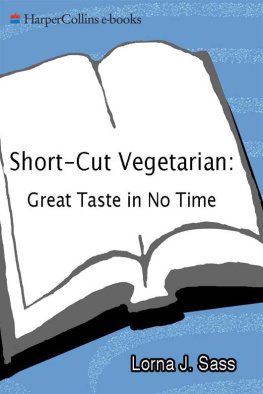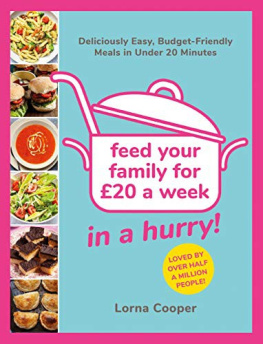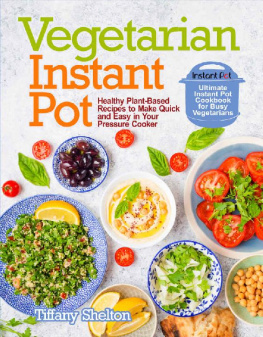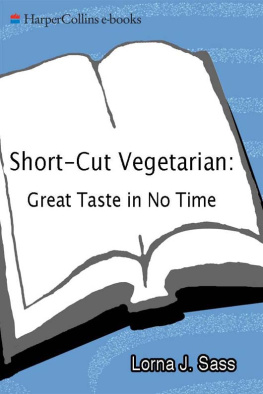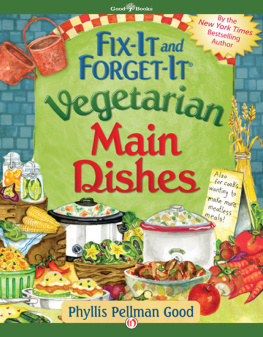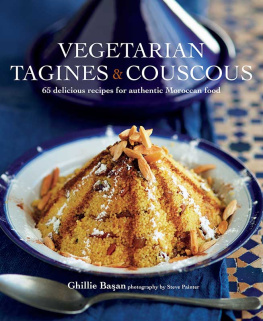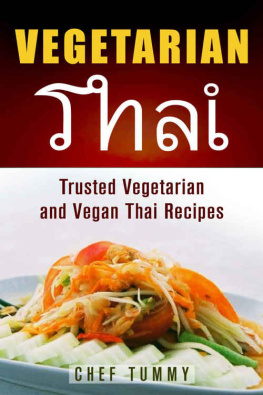

for richard
c ontents
O nce upon a time I believed in cooking everything from scratch. Then life got in the way.
Although I work at homepresumably the ideal circumstance for letting a pot simmer on the back of the stoveI began to find myself more and more frequently coming up against mealtime without a clue about what Id be eating.
Pressure cookingthe subject of previous booksshortened cooking time dramatically, but still involved a fair amount of schlepping and prepping (aka shopping and chopping). Indeed, whenever I gave a lecture on vegetarian cooking or demonstrated one of my favorite lovingly prepared pressure cooker recipes, someone would invariably ask, Is there any way to make really fast vegetarian food?
As one who values eating fresh, wholesome vegetarian meals and considers chopping a form of meditation, I was reluctant to explore the question. But as the pace of life quickened, I found myself joining the growing number of cooks who search for ways to get dinner on the table more quickly.
I decided the first place to start was with a real staple of the vegetarian kitchen: dried beans. I love the taste of beans cooked from scratch, but they always take a bit of advanced planning because I prefer them presoaked. I was never happy with supermarket canned beans, since they are usually so salty and often contain preservatives. So I started, ever so cautiously, to experiment with organic canned beans from my local natural foods store.
I still remember the moment I opened that first can of organic red kidney beans. Sporting their gorgeous bold mahogany skins, these beans not only had great texture but also tasted good. Furthermore, the cooking liquid surrounding them was clear and low in sodiumno need to drain and rinse off any questionable substances.
The simple act of opening that can was a revelationin fact, it awakened me to a whole new realm of quick-cooking culinary possibilities. If I, a hard-line from scratch cook felt good about keeping canned organic beans on hand, ready to prepare a last-minute chili or hummus, what other products and strategies might be available to harried cooks with high standards for quality, wholesomeness, and good taste?
Lorna Sass Short-Cut Vegetarian offers you my hard-earned answers to that question. Writing this book has been an invigoratingoften liberatingexperience. Developing tasty, healthful vegan dishes (no dairy or eggs) that maximize flavor and good nutrition while minimizing preparation and cooking time has stretched my imagination and challenged me to enter realms previously unexplored.
Im delighted to welcome you to Lorna Sass Short-Cut Vegetarian kitchen, a place where very little effort produces substantial rewards. Happy cooking!
LORNA J. SASS
New York City
If youd like to share your favorite short-cut recipes or strategies with me, or if youd like advice on purchasing a pressure cooker, Id be happy to hear from you. Please write to me c/o Cooking Under Pressure, Box 704, New York, NY 10024. Be sure to enclose a SASE if you want a response.
the short-cut vegetarian pantry
Stocking your kitchen with carefully selected high-quality canned, bottled, and dried ingredients is the first step to becoming a successful short-cut cook. Once youve assembled the basic items listed below, youll be able to prepare most of the recipes in this book on the spur of the moment. (You probably have some of them on hand already.) If you feel like expanding your repertoire, you can branch out with other suggested foods as the spirit or a specific recipe moves you.
Almost all of the ingredients used in this book are available at supermarkets and natural food stores, with an occasional foray into a specialty or Asian grocery. During the course of my travels and while testing recipes for this book, I have experimented with numerous brands and developed preferences. For a complete glossary of ingredients including recommended brands, .
ten strategies for short-cut cooking
- Build flavor fast by using secret ingredients that provide intense taste by the spoonful.
- Be creative with carefully selected high-quality instant and prepared foods.
- Explore the versatility of organic canned staples such as beans and diced tomatoes.
- Prepare the whole meal in one pot whenever possible. While the longer-cooking ingredients are simmering away, prepare the items to be added toward the end.
- Cook in quantity and freeze extra for later use.
- Develop an imaginative repertoire of quick-cooking dishes using fresh ingredients that are easy to keep on hand because they dont spoil quicklyfor example, cabbage, potatoes, and carrots.
- Become acquainted with quick-cooking grains like polenta, quinoa, and couscous. Set a kettle of water over high heat even before you take the grains out of the cupboard.
- Rely on the tool or appliance that will get the job done most efficiently.
- Make a mix for fun food like scones, waffles, and cookiesand freeze it in batches for quick treats down the road.
- Dont take cooking (or life) too seriously!
at room temperature
the basics
miscellaneous cans and jars
chickpeas, navy or cannellini beans, and black beans
diced tomatoes with green chilies
diced or crushed tomatoes
tomato-based pasta sauce and salsa
roasted red peppers
pasta and grains
various shapes and sizes, such as tiny (orzo or tubettini), medium (orrecchiette or shells), and long (spaghetti or fettuccine)
white rice (basmati or jasmine and extra-long-grain)
instant polenta
fresh vegetables
garlic, onions, potatoes, and winter squash
branching out
miscellaneous cans and jars
pinto beans, lentils, red kidney beans, and black soybeans
Chinese vegetables, such as bamboo shoots, baby corn, straw mushrooms, and water chestnuts
coconut milk
pasta and grains
asian-style noodles, such as brown-rice udon, soba, or rice noodles
quick-cooking barley
fresh vegetables
plum or beefsteak tomatoes, avocados
miscellaneous
dried beans, such as black, navy, and chickpeas
instant black and refried beans
sun-dried tomatoes (oil-packed)
arame and instant wakame flakes
silken tofu (in aseptic package)
baking soda and baking powder
in the freezer
You might be surprised to find grains, nuts, and flours on this list, but these items will keep longer in the freezer than at room temperature.
the basics
frozen vegetables
corn, chopped spinach, and peas
uncooked grains
whole wheat couscous, brown rice, and quinoa
home-cooked
branching out
miscellaneous
in 1-cup portions
frozen lima beans and artichoke hearts
unsweetened, grated, dried coconut
nuts, such as walnuts and almonds, and seeds, such as sesame and sunflower
whole-grain pastry and all-purpose white flours
quick-toasting nuts and seeds
Next page
